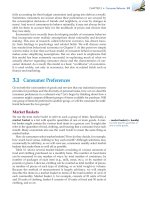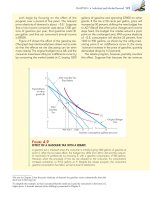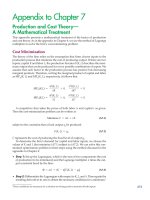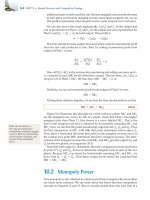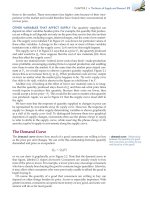(8th edition) (the pearson series in economics) robert pindyck, daniel rubinfeld microecon 117
Bạn đang xem bản rút gọn của tài liệu. Xem và tải ngay bản đầy đủ của tài liệu tại đây (133.01 KB, 1 trang )
92 PART 2 • Producers, Consumers, and Competitive Markets
E XA MPLE 3.5 A COLLEGE TRUST FUND
Jane Doe’s parents have provided a trust fund for
her college education. Jane, who is 18, can receive
the entire trust fund on the condition that she spend
it only on education. The fund is a welcome gift but
perhaps not as welcome as an unrestricted trust. To
see why Jane feels this way, consider Figure 3.17,
in which dollars per year spent on education are
shown on the horizontal axis and dollars spent on
other forms of consumption on the vertical.
The budget line that Jane faces before being
awarded the trust is given by line PQ. The trust fund
expands the budget line outward as long as the full
amount of the fund, shown by distance PB, is spent
on education. By accepting the trust fund and going
to college, Jane increases her satisfaction, moving
from A on indifference curve U1 to B on indifference
curve U2.
Note that B represents a corner solution because
Jane’s marginal rate of substitution of education for
other consumption is lower than the relative price
of other consumption. Jane would prefer to spend
a portion of the trust fund on other goods in addition to education. Without restriction on the trust
fund, she would move to C on indifference curve
U3, decreasing her spending on education (perhaps
going to a junior college rather than a four-year college) but increasing her spending on items that she
enjoys more than education.
Recipients usually prefer unrestricted to restricted
trusts. Restricted trusts are popular, however,
because they allow parents to control children’s
expenditures in ways that they believe are in the
children’s long-run best interests.
Other
consumption
($)
F IGURE 3.17
C
A COLLEGE TRUST FUND
P
B
When given a college trust fund that must be
spent on education, the student moves from A
to B, a corner solution. If, however, the trust fund
could be spent on other consumption as well as
education, the student would be better off at C.
U3
U2
A
U1
Q
Education ($)
3.4 Revealed Preference
In Section 3.1, we saw how an individual’s preferences could be represented by a
series of indifference curves. Then in Section 3.3, we saw how preferences, given
budget constraints, determine choices. Can this process be reversed? If we know
the choices that a consumer has made, can we determine his or her preferences?

